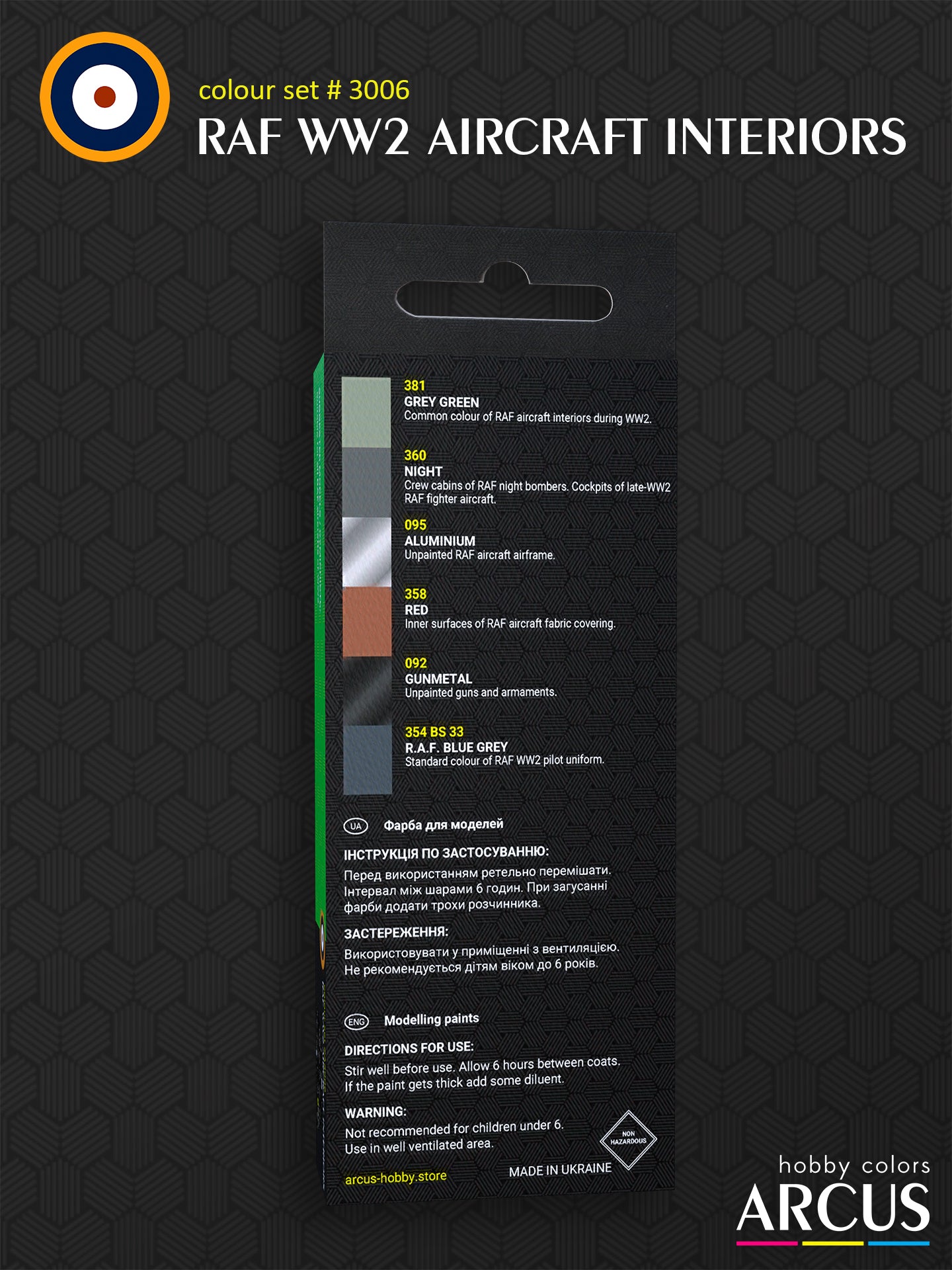Arcus Hobby
Paint Set 3006 RAF WW2 Aircraft interiors
Δεν ήταν δυνατή η φόρτωση της διαθεσιμότητας παραλαβής
RAF WW2 Aircraft Interiors
During World War II, both the Royal Air Force and the Fleet Air Arm of the Royal Navy meticulously designed and maintained their aircraft cockpits, demonstrating a shared commitment to excellence while addressing their unique operational requirements.
For the RAF, the cockpit design emphasized functionality and reliability. Controls and instruments were thoughtfully arranged to facilitate ease of operation, even in the most demanding combat situations. A conservative approach guided their design philosophy, ensuring that cockpit layouts were optimized for pilot effectiveness. Notably, night bomber cockpits were often painted black to blend seamlessly with the darkness of the night sky, aiding in camouflage and reducing the risk of detection by enemy defenses.
In contrast, the FAA, responsible for naval aviation, faced distinct challenges operating from aircraft carriers at sea. Cockpit designs were tailored to maximize pilot effectiveness within the confined spaces of carrier-based aircraft. Similar to the RAF, the FAA prioritized functionality and reliability in cockpit design, while also incorporating features specific to naval aviation, such as enhanced corrosion resistance to withstand the harsh marine environment.
Maintenance procedures within both the RAF and the FAA adhered to strict standards and regulations. Technicians and ground crews received specialized training to ensure the airworthiness of aircraft and address the unique challenges posed by their respective operational environments.
Despite operating within their own set of standards, the RAF and FAA collaborated closely during World War II. This cooperation facilitated the exchange of best practices and ensured alignment across different branches of the military, enhancing the overall effectiveness of Allied air operations.
In summary, the RAF and FAA's approach to aircraft cockpits during World War II underscored a commitment to excellence, functionality, and practicality. By adhering to strict standards and regulations while innovating to meet their specific needs, both organizations ensured that their pilots had the best possible equipment and support to fulfill their vital roles in defending against enemy forces, whether in the skies or over the seas.
Use Guide for the Set RAF WW2 Aircraft Interiors
- Before the Second World War, the British did not paint the cockpits of their combat aircraft in any specific interior color. The metal skin and structural components of the aircraft typically remained in a natural metal finish (although sometimes the airframe was painted black). Wooden parts and plywood skin were also coated with varnish and had the appearance of natural wood, only the fabric covering had a brownish-red dye similar to Dull Red, which was approved for British national insignia just before the Second World War.
- In 1938, with the introduction of aircraft camouflage, it was also decided to paint the interiors of the aircraft with a new gray-green paint. At that time, aircraft in service received gray-green coloring only on the upper parts of the cockpits. Complete interior painting was given only to newly constructed aircraft.
- For better camouflage, the cockpits of night bombers received Night coloring. Starting from the middle of 1942, black cockpit coloring began to be applied to daytime British fighters as well.
Set RAF WW2 Aircraft Interiors Includes:
- 381 Grey Green - A grayish-green color of the aircraft interiors.
- 360 Night - A bluish-black cockpit color of night bombers and late WW2 fighters.
- 095 Aluminum - Unpainted airframe and metal parts.
- 358 Red - A dull red color of the fabric covering.
- 092 Gunmetal - Unpainted guns and armament.
- 354 BS 33 R.A.F. Blue Grey - A dark bluish-gray color of the equipment.
Collection:
This Set is Best for:
- All WW2 RAF & FAA aircraft
Paint Type:
- Acrylic A3006
- Enamel E3006
Paint Finish:
- Semi-gloss
Capacity:
- 6 x 10 ml. (6 x 0.33oz)






